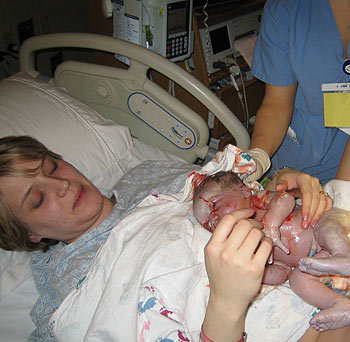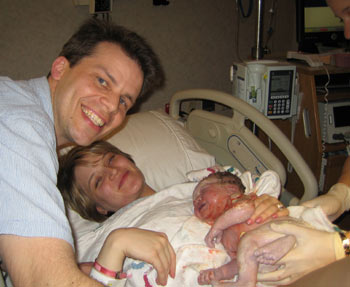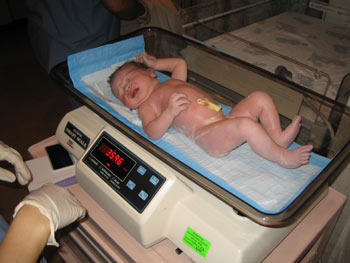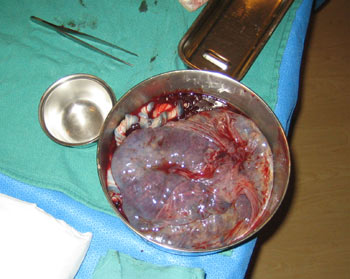


|

|
 In
a few minutes, the epidural was taking effect, and Stacy's pain was almost
entirely relieved. Some feeling remained on her lower right side, and was
anxious to have that feeling numbed by the time new stronger contractions
arrived and the pushing began. In
a few minutes, the epidural was taking effect, and Stacy's pain was almost
entirely relieved. Some feeling remained on her lower right side, and was
anxious to have that feeling numbed by the time new stronger contractions
arrived and the pushing began.
Here is the view from where Stacy lay. It is a troupe of young mom cheerleaders: Amy D. and baby Dan, the other Amy D. and Gene, and Amanda and Jonas standing. |

This pumping machine was hooked up to Stacy's epidural tube. It was labeled Abbott Pain Management Provider. It wasn't actually pumping pain medication. It was just pushing saline-water. The anesthesiologist actually bypassed this setup and manually shot in the pain-killer. So, it was getting down to birthing time. Stacy was happy the baby hadn't decided to emerge on April 1st, and the next looming coincidence was that our baby was going to be born on the same day as Claire's baby, the pregnant character on ABC's hit television show, LOST. At around 6pm, the actual doctor came by to quickly meet us and check Stacy's little monitor readings. The childbirth process is primarily watched over by nurses, and an uncomplicated birth might only require the doctor in the room for 15 minutes. The doctor left quickly, "not yet". He proclaimed, but everyone knew it would be pretty soon. Stacy's contractions continued to arrive in short intervals, and were strong, but not nearly as painful. At 7:25pm, one of Stacy's nurses announced that Stacy was fully dilated, and that it was nearly time to start pushing. At that time, all of our guests left the room, leaving only Stacy and I inside with the nurses.
|
|
For an hour and a half, through about 12 contractions, Stacy did the 1-2-3 pushes, and the baby came closer and closer to emerging. At about 8:40 pm, the baby was very near, and the doctor came in. The doctor put on a catcher's mask and glove. |

At 8:54, the baby finally emerged. Claire's baby on LOST, that is. We were watching ABC on the in-room tv. It didn't seem like Claire had a very rough labor at all. A minute later, with a triumphant and magnificent effort by Stacy, our baby June was born. Our newborn girl was dark red, almost brown, having just emerged from the gestational Jacuzzi. She was wet, with a little blood and smears of a mysterious white coating called vernix caseova. During those first few seconds, my eyes zipped all over the baby's form, looking to see if everything looked alright, to see if the ears were all right, the toes were all right, if the knees were all right. Pregnancy is a long, slow worry, and those first moments when the worry is over, and the baby comes out looking all right, like a good baby... the word relieved doesn't even begin to describe it. I blame the Discovery channel. The baby looked great. Really great. No silver spoon either. |

After the storm, I snuck a look back at the monitor. The little yellow bumps had escalated into an earthquake rollercoaster. Did I mention how relieved we were that the baby was OK? |

The room was fast and furious at this time. The doctor was checking the mother's body and the baby's body, making sure everyone was breathing and bleeding and crying in the right places. Baby June was placed on Stacy's chest, to bond with her, and to keep her distracted from the critical medical attention on her southern hemisphere. If you are worried about how the baby looks in these first pictures, don't panic. New babies are routinely dipped into marinara sauce. It is part of Sutter Medical's new "Hospitaliano" service initiative.
|

The doctor clamped the umbilical cord in two places and handed me the scissors. I cut the cord. After a few minutes, the baby was taken away for some vital statistic gathering. The nurse ignored my "how much is inside" measuring credentials and took the readings herself. Perhaps you can see 3596 grams. Also, the nurse measured her length, and checked for any numbers on her forehead. |

Free, with every child, an umbilical cord and placenta is also born. Everyone knows what the umbilical cord is, but the placenta is just as neat. The placenta is like the baby's lil' helper organ®. Allow me to explain. The baby's blood supply is in a closed system: Her tiny body, the umbilical cord, and the placenta are the only places her baby blood travels. Mom's blood doesn't actually flow into the baby. Her blood flows into the placenta. That is as close to the baby as it gets. In the placenta, mom's blood flows next to the baby's blood supply, where a little trading post is set up, so that the baby can trade CO2 and urine for mom's nutrients, water, and oxygen. I never considered this setup before our baby was born, but of course it makes sense. Otherwise, how could the mom and the baby have different blood types? Because the umbilical cord is filled with the baby's fresh new blood ( cord blood ), it is also packed with stem cells. For this reason, some people hire a cord blood bank to freeze and store their baby's cord blood.
|

Next, the nurse pushed down onto Stacy's abdomen. What was once a bulging belly full of baby now had a lot of extra room. The nurse's hands pushed so far into Stacy's belly, it was very strange and foreign to watch. The reason for this pushing is to massage the uterus and feel to see if it is firm. It kind of reminded me of those Cinnamon Roll commercials. Please continue reading page four. |
| page 1 2 3 4 5 |
Home | Contact Rob | How Much is Inside | Incredible Stuff | Science Club |
April 23rd, 2005. Terms and Conditions Copyright 2005 Cockeyed.com